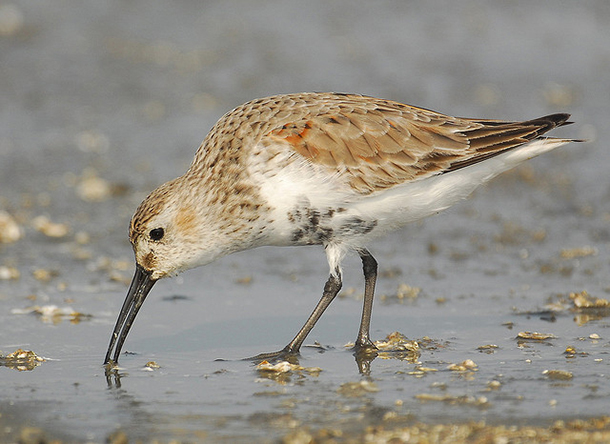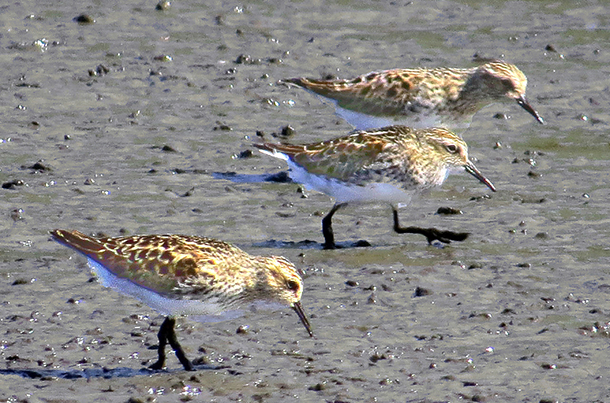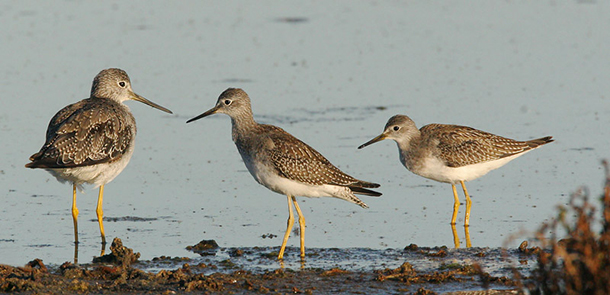BirdNote: Pungent Mudflat
Air Date: Week of September 1, 2017

A Dunlin sandpiper forages in the mudflat. (Photo: Changua Conservation Action, Creative Commons)
Michael Stein samples the sounds and smells of the mudflat in this week’s BirdNote®, encountering sandpipers, dunlins, clams, worms and a variety of powerful odors.
Transcript
[MUSIC: BIRDNOTE® THEME]
CURWOOD: As the water drains away on the Gulf coast, one reality residents will face is mud. But mud can have its uses, as Michael Stein explains in today’s BirdNote.
BirdNote®
The Pungent Mudflat
Written by Bob Sundstrom
[Glaucous-winged gulls crying, evoking the shoreline]
STEIN: Today we’re walking the shoreline of a saltwater bay. The tide’s going out, revealing a broad expanse of dark, glistening mudflat.
This muddy plain might appear a waste of natural space, a mere transient landscape awaiting the rising tide. And that low tide smell! On a hot day, it goes right by pungent, heading for malodorous!

Least sandpipers in the mudflat. (Photo: Richard Griffin)
But that mudflat fragrance offers an important clue. Mudflats are rich in nutrients, such as decomposing organic matter and minerals. Mudflats, far from wastelands, support a bounty of life, such as foraging sandpipers called Dunlin.
[Large flock of Dunlin]
Much of this life lies below the surface. Scoop up a pail of mud and you might find – in addition to a clam or two big enough to eat – vast quantities of tiny snails and clams, worms, crustaceans, larvae, and much more.
Mudflats also support a bounty of bird life. Millions of shorebirds follow shorelines and their mudflats each spring and fall, where they feast upon those tiny creatures hidden beneath the mud’s surface, a banquet that powers the birds’ continent-spanning migrations.
So the next time you wrinkle your nose at low tide, imagine the countless creatures that draw their lifeblood from that fragrant mudflat.
[Glaucous-winged gulls crying, evoking the shoreline]

Greater and Lesser Yellowlegs. (Photo: Tom Grey)
I’m Michael Stein.
###
Sounds of birds provided by The Macaulay Library of Natural Sounds at the Cornell Lab of Ornithology, Ithaca, New York. Calls of Glaucous-winged Gull 137881 recorded by G. Vyn; calls of flock of Dunlin 59435-2 by W.W. H. Gunn
Mudflat ambient with gulls recorded by C. Peterson.
Producer: John Kessler
Executive Producer: Chris Peterson
© 2012-2017 Tune In to Nature.org, September 2017 Narrator: Michael Stein
http://birdnote.org/show/pungent-mudflat
CURWOOD: For photos, ooze on over to our website, LOE.org.
Links
Living on Earth wants to hear from you!
Living on Earth
62 Calef Highway, Suite 212
Lee, NH 03861
Telephone: 617-287-4121
E-mail: comments@loe.org
Newsletter [Click here]
Donate to Living on Earth!
Living on Earth is an independent media program and relies entirely on contributions from listeners and institutions supporting public service. Please donate now to preserve an independent environmental voice.
NewsletterLiving on Earth offers a weekly delivery of the show's rundown to your mailbox. Sign up for our newsletter today!
 Sailors For The Sea: Be the change you want to sea.
Sailors For The Sea: Be the change you want to sea.
 The Grantham Foundation for the Protection of the Environment: Committed to protecting and improving the health of the global environment.
The Grantham Foundation for the Protection of the Environment: Committed to protecting and improving the health of the global environment.
 Contribute to Living on Earth and receive, as our gift to you, an archival print of one of Mark Seth Lender's extraordinary wildlife photographs. Follow the link to see Mark's current collection of photographs.
Contribute to Living on Earth and receive, as our gift to you, an archival print of one of Mark Seth Lender's extraordinary wildlife photographs. Follow the link to see Mark's current collection of photographs.
 Buy a signed copy of Mark Seth Lender's book Smeagull the Seagull & support Living on Earth
Buy a signed copy of Mark Seth Lender's book Smeagull the Seagull & support Living on Earth

